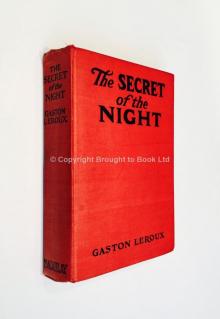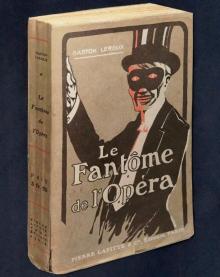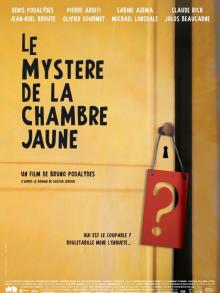- Home
- Gaston Leroux
Le mystère de la chambre jaune. English Page 7
Le mystère de la chambre jaune. English Read online
Page 7
Here is the ground plan of the pavilion. It had a ground-floor which wasreached by a few steps, and above it was an attic, with which we neednot concern ourselves. The plan of the ground-floor only, sketchedroughly, is what I here submit to the reader.
1. The Yellow Room, with its one window and its one door opening into the laboratory.
2. Laboratory, with its two large, barred windows and its doors, one serving for the vestibule, the other for The Yellow Room.
3. Vestibule, with its unbarred window and door opening into the park.
4. Lavatory.
5. Stairs leading to the attic.
6. Large and the only chimney in the pavilion, serving for the experiments of the laboratory.
The plan was drawn by Rouletabille, and I assured myself that there wasnot a line in it that was wanting to help to the solution of theproblem then set before the police. With the lines of this plan and thedescription of its parts before them, my readers will know as much asRouletabille knew when he entered the pavilion for the first time. Withhim they may now ask: How did the murderer escape from The Yellow Room?Before mounting the three steps leading up to the door of the pavilion,Rouletabille stopped and asked Monsieur Darzac point blank:
"What was the motive for the crime?"
"Speaking for myself, Monsieur, there can be no doubt on the matter,"said Mademoiselle Stangerson's fiance, greatly distressed. "The nails ofthe fingers, the deep scratches on the chest and throat of MademoiselleStangerson show that the wretch who attacked her attempted to commit afrightful crime. The medical experts who examined these traces yesterdayaffirm that they were made by the same hand as that which left its redimprint on the wall; an enormous hand, Monsieur, much too large to gointo my gloves," he added with an indefinable smile.
"Could not that blood-stained hand," I interrupted, "have been the handof Mademoiselle Stangerson who, in the moment of falling, had pressed itagainst the wall, and, in slipping, enlarged the impression?"
"There was not a drop of blood on either of her hands when she waslifted up," replied Monsieur Darzac.
"We are now sure," said I, "that it was Mademoiselle Stangerson who wasarmed with Daddy Jacques's revolver, since she wounded the hand of themurderer. She was in fear, then, of somebody or something."
"Probably."
"Do you suspect anybody?"
"No," replied Monsieur Darzac, looking at Rouletabille. Rouletabillethen said to me:
"You must know, my friend, that the inquiry is a little more advancedthan Monsieur de Marquet has chosen to tell us. He not only knows thatMademoiselle Stangerson defended herself with the revolver, but he knowswhat the weapon was that was used to attack her. Monsieur Darzac tellsme it was a mutton-bone. Why is Monsieur de Marquet surroundingthis mutton-bone with so much mystery? No doubt for the purpose offacilitating the inquiries of the agents of the Surete? He imagines,perhaps, that the owner of this instrument of crime, the most terribleinvented, is going to be found amongst those who are well-known in theslums of Paris who use it. But who can ever say what passes through thebrain of an examining magistrate?" Rouletabille added with contemptuousirony.
"Has a mutton-bone been found in The Yellow Room?" I asked him.
"Yes, Monsieur," said Robert Darzac, "at the foot of the bed; but I begof you not to say anything about it." (I made a gesture of assent.) "Itwas an enormous mutton-bone, the top of which, or rather the joint, wasstill red with the blood of the frightful wound. It was an old bone,which may, according to appearances, have served in other crimes. That'swhat Monsieur de Marquet thinks. He has had it sent to the municipallaboratory at Paris to be analysed. In fact, he thinks he has detectedon it, not only the blood of the last victim, but other stains of driedblood, evidences of previous crimes."
"A mutton-bone in the hand of a skilled assassin is a frightful weapon,"said Rouletabille, "a more certain weapon than a heavy hammer."
"The scoundrel has proved it to be so," said Monsieur Robert Darzac,sadly. "The joint of the bone found exactly fits the wound inflicted.
"My belief is that the wound would have been mortal, if the murderer'sblow had not been arrested in the act by Mademoiselle Stangerson'srevolver. Wounded in the hand, he dropped the mutton-bone and fled.Unfortunately, the blow had been already given, and Mademoiselle wasstunned after having been nearly strangled. If she had succeededin wounding the man with the first shot of the revolver, she would,doubtless, have escaped the blow with the bone. But she had certainlyemployeeed her revolver too late; the first shot deviated and lodged inthe ceiling; it was the second only that took effect."
Having said this, Monsieur Darzac knocked at the door of the pavilion. Imust confess to feeling a strong impatience to reach the spot where thecrime had been committed. It was some time before the door was opened bya man whom I at once recognised as Daddy Jacques.
He appeared to be well over sixty years of age. He had a long whitebeard and white hair, on which he wore a flat Basque cap. He was dressedin a complete suit of chestnut-coloured velveteen, worn at the sides;sabots were on his feet. He had rather a waspish-looking face, theexpression of which lightened, however, as soon as he saw MonsieurDarzac.
"Friends," said our guide. "Nobody in the pavilion, Daddy Jacques?"
"I ought not to allow anybody to enter, Monsieur Robert, but of coursethe order does not apply to you. These gentlemen of justice have seeneverything there is to be seen, and made enough drawings, and drawn upenough reports--"
"Excuse me, Monsieur Jacques, one question before anything else," saidRouletabille.
"What is it, young man? If I can answer it--"
"Did your mistress wear her hair in bands, that evening? You know what Imean--over her forehead?"
"No, young man. My mistress never wore her hair in the way you suggest,neither on that day nor on any other. She had her hair drawn up, asusual, so that her beautiful forehead could be seen, pure as that of anunborn child!"
Rouletabille grunted and set to work examining the door, finding that itfastened itself automatically. He satisfied himself that it could neverremain open and needed a key to open it. Then we entered the vestibule,a small, well-lit room paved with square red tiles.
"Ah! This is the window by which the murderer escaped!" saidRouletabille.
"So they keep on saying, monsieur, so they keep on saying! But if he hadgone off that way, we should have been sure to have seen him. We are notblind, neither Monsieur Stangerson nor me, nor the concierges who arein prison. Why have they not put me in prison, too, on account of myrevolver?"
Rouletabille had already opened the window and was examining theshutters.
"Were these closed at the time of the crime?"
"And fastened with the iron catch inside," said Daddy Jacques, "and I amquite sure that the murderer did not get out that way."
"Are there any blood stains?"
"Yes, on the stones outside; but blood of what?"
"Ah!" said Rouletabille, "there are footmarks visible on the path--theground was very moist. I will look into that presently."
"Nonsense!" interrupted Daddy Jacques; "the murderer did not go thatway."
"Which way did he go, then?"
"How do I know?"
Rouletabille looked at everything, smelled everything. He went downon his knees and rapidly examined every one of the paving tiles. DaddyJacques went on:
"Ah!--you can't find anything, monsieur. Nothing has been found. And nowit is all dirty; too many persons have tramped over it. They wouldn'tlet me wash it, but on the day of the crime I had washed the floorthoroughly, and if the murderer had crossed it with his hobnailed boots,I should not have failed to see where he had been; he has left marksenough in Mademoiselle's chamber."
Rouletabille rose.
"When was the last time you washed these tiles?" he asked, and he fixedon Daddy Jacques a most searching look.
"Why--as I told you--on the day of the crime, towards half-pastfive--while Mademoiselle and her father w
ere taking a little walk beforedinner, here in this room: they had dined in the laboratory. The nextday, the examining magistrate came and saw all the marks there were onthe floor as plainly as if they had been made with ink on white paper.Well, neither in the laboratory nor in the vestibule, which were bothas clean as a new pin, were there any traces of a man's footmarks. Sincethey have been found near this window outside, he must have made his waythrough the ceiling of The Yellow Room into the attic, then cut his waythrough the roof and dropped to the ground outside the vestibule window.But--there's no hole, neither in the ceiling of The Yellow Room norin the roof of my attic--that's absolutely certain! So you see we knownothing--nothing! And nothing will ever be known! It's a mystery of theDevil's own making."
Rouletabille went down upon his knees again almost in front of a smalllavatory at the back of the vestibule. In that position he remained forabout a minute.
"Well?" I asked him when he got up.
"Oh! nothing very important,--a drop of blood," he replied, turningtowards Daddy Jacques as he spoke. "While you were washing thelaboratory and this vestibule, was the vestibule window open?" he asked.
"No, Monsieur, it was closed; but after I had done washing the floor, Ilit some charcoal for Monsieur in the laboratory furnace, and, as I litit with old newspapers, it smoked, so I opened both the windows in thelaboratory and this one, to make a current of air; then I shut those inthe laboratory and left this one open when I went out. When Ireturned to the pavilion, this window had been closed and Monsieur andMademoiselle were already at work in the laboratory."
"Monsieur or Mademoiselle Stangerson had, no doubt, shut it?"
"No doubt."
"You did not ask them?"
After a close scrutiny of the little lavatory and of the staircaseleading up to the attic, Rouletabille--to whom we seemed no longer toexist--entered the laboratory. I followed him. It was, I confess, ina state of great excitement. Robert Darzac lost none of my friend'smovements. As for me, my eyes were drawn at once to the door ofThe Yellow Room. It was closed and, as I immediately saw, partiallyshattered and out of commission.
My friend, who went about his work methodically, silently studiedthe room in which we were. It was large and well-lighted. Two bigwindows--almost bays--were protected by strong iron bars and looked outupon a wide extent of country. Through an opening in the forest, theycommanded a wonderful view through the length of the valley and acrossthe plain to the large town which could be clearly seen in fair weather.To-day, however, a mist hung over the ground--and blood in that room!
The whole of one side of the laboratory was taken up with a largechimney, crucibles, ovens, and such implements as are needed forchemical experiments; tables, loaded with phials, papers, reports,an electrical machine,--an apparatus, as Monsieur Darzac informed me,employeeed by Professor Stangerson to demonstrate the Dissociation ofMatter under the action of solar light--and other scientific implements.
Along the walls were cabinets, plain or glass-fronted, through whichwere visible microscopes, special photographic apparatus, and a largequantity of crystals.
Rouletabille, who was ferreting in the chimney, put his fingers into oneof the crucibles. Suddenly he drew himself up, and held up a piece ofhalf-consumed paper in his hand. He stepped up to where we were talkingby one of the windows.
"Keep that for us, Monsieur Darzac," he said.
I bent over the piece of scorched paper which Monsieur Darzac tookfrom the hand of Rouletabille, and read distinctly the only words thatremained legible:
"Presbytery--lost nothing--charm, nor the gar--its brightness."
Twice since the morning these same meaningless words had struck me, and,for the second time, I saw that they produced on the Sorbonne professorthe same paralysing effect. Monsieur Darzac's first anxiety showeditself when he turned his eyes in the direction of Daddy Jacques.But, occupied as he was at another window, he had seen nothing. Thentremblingly opening his pocket-book he put the piece of paper into it,sighing: "My God!"
During this time, Rouletabille had mounted into the opening of thefire-grate--that is to say, he had got upon the bricks of a furnace--andwas attentively examining the chimney, which grew narrower towards thetop, the outlet from it being closed with sheets of iron, fastened intothe brickwork, through which passed three small chimneys.
"Impossible to get out that way," he said, jumping back into thelaboratory. "Besides, even if he had tried to do it, he would havebrought all that ironwork down to the ground. No, no; it is not on thatside we have to search."
Rouletabille next examined the furniture and opened the doors of thecabinet. Then he came to the windows, through which he declared no onecould possibly have passed. At the second window he found Daddy Jacquesin contemplation.
"Well, Daddy Jacques," he said, "what are you looking at?"
"That policeman who is always going round and round the lake. Another ofthose fellows who think they can see better than anybody else!"
"You don't know Frederic Larsan, Daddy Jacques, or you wouldn't speak ofhim in that way," said Rouletabille in a melancholy tone. "If thereis anyone who will find the murderer, it will be he." And Rouletabilleheaved a deep sigh.
"Before they find him, they will have to learn how they lost him," saidDaddy Jacques, stolidly.
At length we reached the door of The Yellow Room itself.
"There is the door behind which some terrible scene took place," saidRouletabille, with a solemnity which, under any other circumstances,would have been comical.

 The Mystery of the Yellow Room
The Mystery of the Yellow Room The Secret of the Night
The Secret of the Night In Letters of Fire
In Letters of Fire The Phantom of the Opera
The Phantom of the Opera Fantôme de l'Opéra. English
Fantôme de l'Opéra. English Collected Works of Gaston Leroux
Collected Works of Gaston Leroux Le mystère de la chambre jaune. English
Le mystère de la chambre jaune. English Cheri-Bibi: The Stage Play
Cheri-Bibi: The Stage Play The Phantom of the Opera (Oxford World's Classics)
The Phantom of the Opera (Oxford World's Classics) Rouletabille and the Mystery of the Yellow Room
Rouletabille and the Mystery of the Yellow Room The Perfume of the Lady in Black
The Perfume of the Lady in Black The Bloody Doll
The Bloody Doll Rouletabille at Krupp's
Rouletabille at Krupp's Phantom of the Opera (Barnes & Noble Classics Series)
Phantom of the Opera (Barnes & Noble Classics Series)